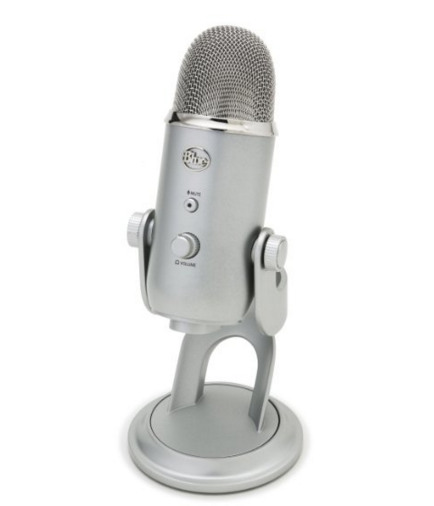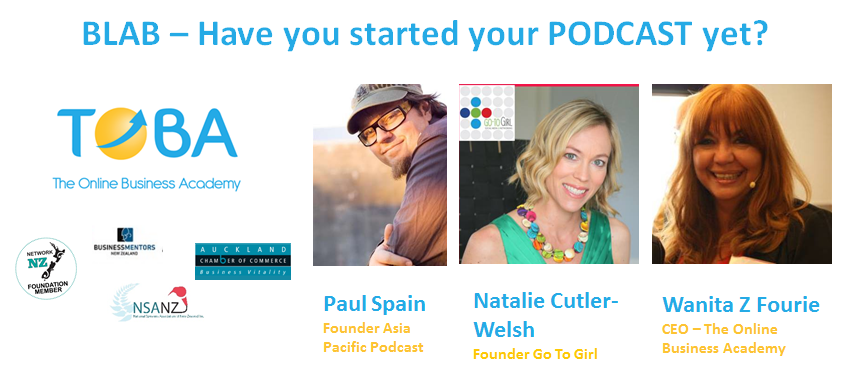On the 11 January 2016, I had the pleasure of having Paul Spain and Natalie Cutler-Welsh on my BLAB, to discuss Podcasting. Podcasting can open up a mirade of relationships and new clients.
Introducing Paul Spain
Paul Spain is the Founder of the Asia Pacific Podcast Conference which is being held on the 12th and 13th February 2016. Paul has been involved in Digital Media even before it was known as Digital Media. In 2002, he launched a Social Network which they grew to around 300 000 members around the world – pretty impressive huh? Considering that this was pre Facebook.
These days, with Global Voice Media, he is involved in Podcasting for just over 5 years. They launched The New Zealand Tech Podcast in early 2011 and they topped iTunes on their 3rd episode. Since then, he has been growing a podcasting network. He is very interested in podcasting in regional areas and in niches. His passion to to get people involved that are a little more local to the Asia Pacific Region as most of the podcasts are being run from the USA.
Introducing Natalie Cutler-Welsh
Natalie is the Founder of GoToGirl – Social Media and Networking for the last 3+ years. She works primarily with women entrepreneurs where she connects them and coaches them so that they can have more fun and flow in their business. She has jsut completed episode no 100 on her GoToGirl Podcast, and 125 podcast episodes of ‘If only they told me’ (parenting podcast) previously with her co host Jackie.
About the Asia Pacific Podcasting Conference:
Special Guest – Cliff Ravenscraft from the USA who is also know as Podcastanswerman.
The last time we checked he was on Podcast no 431. He was the Speaker that stood out the most for Paul Spain at the Podcast Movement Conference in the USA, and is fully booked with keynote talks for the year so we were very fortunate to secure him for the conference.
Here is the BLAB and you can read the gems below the video if you don’t want to watch the whole episode.
This content has been ordered in a structure way and not necessarily according to the flow of the Blab information.
PODCASTING GEMS
What is Podcasting?
Paul: There is a lot of debate over the word podcasting. For most people that listen to podcasts, they are listening to pre recorded audio, and they will be listening to it played back through a podcast player or podcatcher. The most popular being Apple with their Podcast App on their iPhone and then a whole range of podcast apps on Android. There is also iTunes as well where people pull down their podcasts. To define it in it’s entirety is a bit broader. There are video podcasts and certainly BLAB fits into that. People are now using apps to get Podcasts on demand. It’s audio on demand the same way that Netflix is video on demand.
Part of the reason I do podcasting is the social interaction, I like to hang out with people – it’s fun’
Natalie: ‘Podcasting is so amazing for sharing knowledge consistently. I have people contact me regularly and say, I have been listening to your podcast for 2 years, I thought I’d get in touch and see how you can help my business.’
Where to start?
The key is finding something that you are really passionate about, knowledgeable about and you are prepared to put that time together each week. (Paul)
Really understand what you are going to podcast about, why you are going to podcast, what is the benefit? What is it going to do for your business or your online presence and what do you want to achieve out of it.
For Natalie – it is about dedication. It can take 3 hours per episode.
Prepare your show notes.
Understand the 4 P’
- Profile
- Positioning
- Passion
- People – know your niche
How to structure your podcast.
Plan
- Plan your podcasts in advance.

- Have some in the ‘bank’ for when you go on holiday.
- Make sure you save episodes in a dedicated folder using a date format and the name of the person being interviewed.
- Get a good microphone and test that it works. Later on you can get better equipment like a mixer. If you don’t have a good microphone and you your content is great – you can still loose people because their method of learning is audio.
Click here to look at the range of Blue Yeti Microphones.
The one in 5 – by Natalie
- Monologue episode – me just talking
- Four interviews
Intro and Outro
- Always try and do this in real time. (Natalie)
Prepare your Guest
Work out your formula and format so that your guests are prepared so that they look and sound good. This produces great quality podcasts and results. Here are a few examples of how to prepare your guest.
- Have a page on your website to to brief the guest – e.g. here are a couple of previous podcasts to listen to, these are the questions we would be asking, this is how you prepare. Wear headphones and have water available etc.
- Give personality types what they need – for example an opportunity to practise ahead of time with questions. (ps Do be prepared yourself on the day and don’t ask different questions. This happened to me once and it threw my flow completely. Not because I am not flexible but because I knew the interviewer was very structured and so I was thrown by their unpreparedness).
How to create your content.
Natalie – It’s really good for people to know their goal. If they have an upsell, it’s good to know so that you can link it in. For example if you have a 6 weeks course that you run, it’s really good to theme your podcasts in the lead up to that course so that you are sharing snippets or knowledge, you’re dropping breadcrumbs throughout the podcast.
Natalie Eckdahl from the bizchix podcast does very well because she does themes. For example at one point she was doing one all about masterminding and then you can do three of four podcasts around this theme.
Running a podcast.
- Ideally at the same time next week
- Be consistent.
- Having someone come and record in studio produces a different vibe and dynamic.
- Natalie does not edited out the um’s and ah’s as people are not perfect. It creates an authenticity. Other people would edit this out. Choose what works for you.
- BLAB is as real and authentic as you are going to get.
Editing a Podcast
- If you have the finances, try and employ a podcast editor
- Make it professional with the intro, outro and music.
Getting Followers
Paul – You have to work at building an audience whether it’s a mailing list, or through social media. All of these channels will help you. You can move this into an offline context too. Listen to how Paul did this at an Apple Store. (29 minutes). Also spread the word amongst your friends.
- If you can get into the charts on iTunes, that certainly helps.
- Think about how you can get found in search engines.
- Create create content – if the content is awesome and relevant to your audience, then over time they are going to tell people.
- Ultimately getting good people on your show.
- Connect with the right people – they can.
What would you have done differently if you knew what you know now?
Natalie:
No 1: Have an opt-in form and made sure that it is compelling – for example ‘Sign up for our ten top tips’. Amy Porterfield creates an offer for everything she does.
No2: This is one of John Loomer’s tips – Boost your posts. Schedule 40 tweets over a two week period about that one particular podcast. Schedule about 5 posts on Facebook over a two week period. This way you ensure you capture your people and you build a following.
Paul:
No 1: Planning ahead is very important. One of the first things I did was create a document that we could share and talk about. Set this up in a way that everyone can collaborate so that if others have ideas and they want to contribute. That document helps us keep on track with some of our ways of doing podcastings. For example – comments around certain language to use ie. don’t use acronyms because you might leave people behind. Makes it easy for me because I can just add to the document anytime and anywhere I go. I can add content as I am consuming it online and add this to the agenda.
The document is usually a very simple document. It includes the title for the episode, the date, who the guest/s are, three of four key instructions, area where guests can add in their comments in relation to topics that can be discussed, then bullet points of the topics to discuss and each of those has a web link back to them.
No 2: The more that you can learn from others techniques, the better.
Thank you for joining is and we look forward to our next BLAB, don’t forget to join.



Leave A Comment